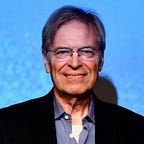Cinema: The Known. The Invented. A Partnership.
The symbiosis of learning and invention
The English conservative commentator Michael Oakeshott observed that:
The task of the teacher is to free his pupils from servitude to the present.
(Mr. Oakeshott, why are the teacher’s pupils necessarily his?)
The English/American liberal commentator of this article replies:
The task of the student is to free their teacher from servitude to the past.
Question: Could both Oakeshott and myself be correct?
A highly successful writer-director-screenwriter, at the time my student, once asked why I’d spent over ten hours taking the class through Hitchcock’s Notorious when we don’t make movies that way anymore.
Another student, after I had broken down one of Scorsese’s complex sequence shots, its consecutive, component vignettes, its layered focal planes, dual passage of time, and bravura camera movement, remarked But we don’t shoot like that now!
It was as though they were suggesting that understanding the thought behind the execution of a shot limits us to parroting that shot mechanically rather than informing our own insights so that we may better formulate our own, fresh approach…
After one recent class, a notably talented young cinematographer said to me I didn’t realize you could learn from an old movie!
It’s as though each generation thinks it has to start anew with no foundations to build upon.
As though what has come before had built-in obsolescence.
As though the nature of human experience, of desire, love, fear, hate, lust, intimacy, need, vanity, insecurity, heroism, cowardice, violence, compassion, disappointment, aspiration, hope, thought, reflection, denial, epiphany change inexorably generation by generation…
As though the nature of story and the challenges of storytelling mutate decade by decade so that the questions asked today by say… Emerald Fennell or Charlotte Wells are somehow radically different from those asked by say… Edwin Porter or Charlie Chaplin.
As though the screen, that planarity before us, has altered more than its aspect ratio and morphed in its nature, age by succeeding age, into something indefinably different from what it’s been before.
As though the screen’s language, its practical aesthetics of today bear no resemblance to its preceding counterparts.
As though changes in technology, in equipment, in cameras change everything else.
As though changes in taste change everything else.
As though we are with each superseding generation doomed to cultural, emotional, and artistic amnesia.
As though we are condemned to invention without memory.
As though memory is an obstacle to invention.
As though awareness of the past is an obstacle to new vision.
As though learning and knowledge must be severed from the creative process.
As though there can be no evolution, only a starting out again… and again… and again…
I once read that PT Anderson kept TCM on in every room in his house so that as he moved from one to another, he could maintain sight of the images from the movie playing.
Perhaps that’s why PTA, Steven Spielberg, and Martin Scorsese recently joined forces to protect the network:
https://ew.com/tv/tcm-insiders-detail-fight-to-protect-turner-classic-movies-network/
Because when the past is lost, so is the present, so is the future.
As an educator, I’ve been fortunate to have worked with many outstanding new filmmakers. Among the most film-literate, probably the most film literate (not to mention the most literature-literate) has to have been Ari Aster. Ari’s encyclopedic film history awareness hardly seems to have prevented him from becoming such an astonishing and inventive newcomer over recent years.
New technology, new “platforms”, new methods of distribution are often presented as fundamental cinematic progress. They are not. Of course they may have profound effects, for the better or worse, on the well-being of the art of the filmmaker, but the delivery system is not the item to be delivered. The conveyor belt is not the candy.
Each generation finds its own voice. Each its own idioms. Each its own stories. Each its own cinema.
But also… each discovers its own understanding of the past, of the language of its predecessors.
And that fresh insight prompts, informs, nourishes, inspires fresh invention.
So perhaps: The task of the teacher is to free his pupils from servitude to a present which owes nothing to its past.
While: The task of the student is to free their teacher from servitude to the fixed past and show them how what has come before can be understood in new ways that prompt new approaches.
Plus, of course, astonishing the teacher with those new approaches…
Peter Markham September 2023
Author:
The Art of the Filmmaker: The Practical Aesthetics of the Screen. (Oxford University Press) 10/13
What’s the Story? The Director Meets Their Screenplay. (Focal Press/Routledge) 9/20
Thank you for reading. Please comment! Your questions and critiques are greatly appreciated.
